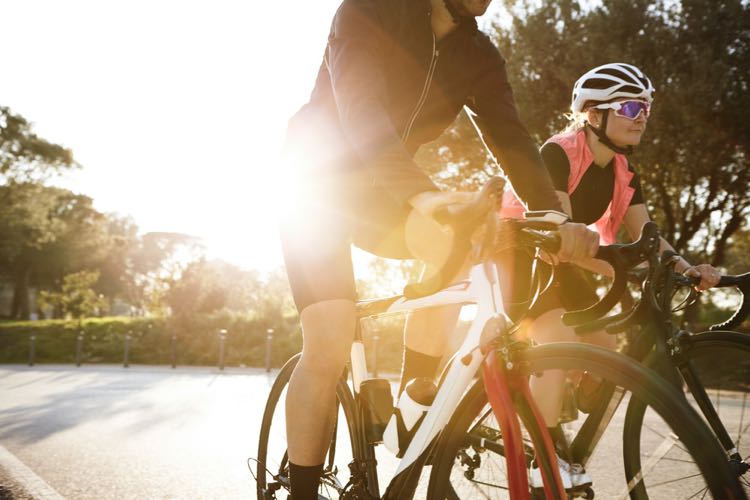Cycling Etiquette and Signals for Safer Riding

Two cyclists ride side-by-side while following cycling etiquette and using hand signals to stay safe. (Photo: Shutterstock)
As a new triathlete or cyclist, it is truly hard to know where to begin. You need a bike, a helmet, a bike rack, clothing, and chamois-things and lube-y things. You need to have a good bike fit, know how to change a tube, and understand the rules of the road. After all of that, then you must learn how to actually ride the darn bike and also stay up on two wheels. It’s a tall order, people.
The list may often feel long and arduous to become a cyclist as an adult, even if you loved to ride your bike as a kid. Never mind the fact that if you are doing triathlon, you are getting on this bike all sopping wet and flying out of transition like a crazy person. Riding bicycles while soaking wet? Apparently, it’s a thing in this sport.
But like the adult-onset runner or adult-onset swimmer, we adult-onset cyclists can go on to do well on two wheels, too. There are just a few things to keep in mind – okay a lot of things – but the more we know, the better we can set ourselves up for success.
Cycling etiquette for the new rider
You can start out on trails or in your neighborhood, but eventually the cyclists take the show on the road. Here’s the quick and dirty of things to consider, learn, and embody as a new cyclist on the road:
- Wear your helmet. Always. With the strap fastened snugly.
- Wear your sunglasses (yes, this is for eyeball safety!). If it’s dark outside, then wear clear ones.
- Wear your safety ID with your emergency contact information.
- Where you look, you may “go” – learn to hold your bike steady and be aware of your surroundings. But don’t focus on trees, cars, and curbs – or you might find yourself riding into them.
- Do not ride on the sidewalk. Sidewalks are for pedestrian traffic.
- Do not ride with headphones. Seriously. Don’t. Also, do not talk on your phone.
- Pretend you are a car. Ride on the same side of the road as the cars, with the traffic. For example, in the U.S., you will want to ride on the right side of the road. Use hand signals for turning.
- If you are riding with a group, use signals such as pointing at the road below to indicate to the riders behind you that there is something in the road (e.g., pothole, crack, debris). This will help the people behind you avoid dangers that you can clearly see.
- When approaching another rider from behind, signal with your voice: “on your left” before you pass. Give the rider as wide of a space as possible when passing.
- If there is a car coming up from the rear, shout “car back!” to the riders in front of you to let them know. Same with “car up” to signal there is an oncoming car before a turn or stop.
- If you are at an intersection and the road is clear to cross, you can shout “clear!” or “clear right and clear left!” and proceed to cross. This will signal to the riders behind you that it is safe to cross so they do not have to clip out of their pedals. Of course, you will want to be certain that it is, in fact, clear. Additionally, make sure that they are just a few seconds behind you because obviously “clear” can change pretty quickly.
- Learn to “hold your line” – meaning, learn to ride in a straight line. And stay there.
- Look over your left shoulder every once in a while to check for cars, other riders, etc., but learn to do so without also veering in the direction that you are looking. This takes practice because our bodies want to steer the bike in the direction of our heads, so practice this often.
- Stay as far right as you possibly and safely can. Note that when the roads are wet, you should stay off of the painted lines, because they can be slick when wet.
- No “cross wheeling.” In other words, don’t ride too close behind and to the side of another rider. If they veer to the right and you are too close behind and to the side, then your front wheel may get caught in their rear wheel and cause a crash.
- It is fun to ride side-by-side and chit-chat with your friends. Keep in mind that this is (technically) poor cycling etiquette and annoying to the cars and trucks sharing the road. At the same time, this is part of the fun of group rides. Just bear in mind that if you are on a well-traveled route, you “should” ride in a single file and save the side-by-side rides for empty country roads.
- Have fun, breathe, and just keep cycling forward!
Cycling hand signals
Before you hit the roads on go on your first group ride. Familiarize yourself with these cycling hand signals.
Slowing
To indicate that a cyclist is slowing, they will place their left arm straight down, just below their hip.

Turning left
Cyclists place their left arm straight out to show that they are turning left.

Turning right
When a cyclist is about to turn right, they will place their left hand up at a 90-degree angle.

Slow
To ensure they don’t get rear-ended, a cyclist will place their left arm down with elbow up, creating a 90-degree angle to indicate that they are slowing down.
